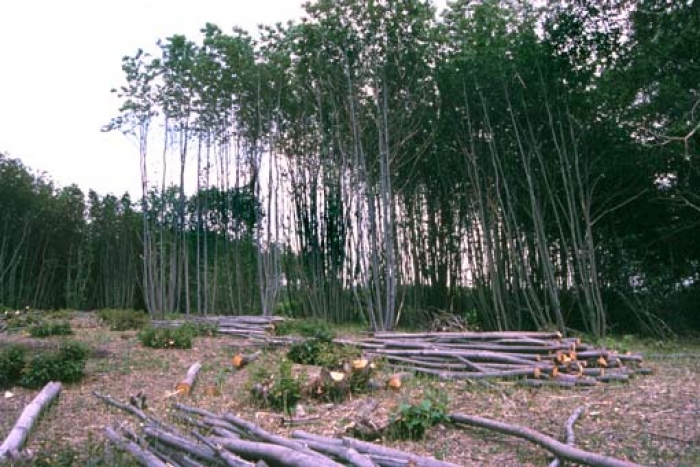 Sweet chestnut is thought to have been introduced by the Romans from southern Europe and has been grown in the UK for some 2,000 years: extant ancient trees include the Tortworth chestnut in Gloucestershire, reputed to be over 1,000 years old. The main chestnut area of 18,000 ha is concentrated in England, especially in the southern counties of Kent and Sussex, where there are extensive stands of commercial coppice, often grown with oak standards (see photo right). In the UK, chestnut is grown solely for its timber as nut production is not currently economically viable under UK growing conditions. It is presently a minor species in Irish forestry, but nevertheless appears on 191 sub-compartment records in the Republic. Although very much a lowland species here, recent research findings have shown that when grown in a matrix of suitable nurse species, its planting range can be extended to moderately exposed sites.
Sweet chestnut is thought to have been introduced by the Romans from southern Europe and has been grown in the UK for some 2,000 years: extant ancient trees include the Tortworth chestnut in Gloucestershire, reputed to be over 1,000 years old. The main chestnut area of 18,000 ha is concentrated in England, especially in the southern counties of Kent and Sussex, where there are extensive stands of commercial coppice, often grown with oak standards (see photo right). In the UK, chestnut is grown solely for its timber as nut production is not currently economically viable under UK growing conditions. It is presently a minor species in Irish forestry, but nevertheless appears on 191 sub-compartment records in the Republic. Although very much a lowland species here, recent research findings have shown that when grown in a matrix of suitable nurse species, its planting range can be extended to moderately exposed sites.
Sweet chestnut is usually considered an ‘honorary native’ in southern England: it has a reasonable claim to be able to maintain levels of wildlife biodiversity similar to that of native broadleaved woodland. The timber is naturally durable, with few sapwood rings, and requires no preservatives for outdoor use. Mature standard trees are highly valued for their timber: their suitability for furniture and for other purposes is similar to that of oak. However, large diameter stems of chestnut can be susceptible to timber defects, especially ring shake and spiral grain. Fortunately, with the advancement of saw technology, together with modern wet gluing technology, beams can now be manufactured for the structural utilisation of small diameter chestnut timber.
Climate chang e and declining markets, together with biotic factors (such as the fungal diseases Phytophthora spp (causing ‘ink’ disease) and Cryphonectria spp (causing Chestnut blight, not yet present in the UK)) pose potential threats to the species across Europe. Geographic differentiation between populations in Europe is reflected by variation in adaptive traits such as budburst, bud set or growth rate: populations from wetter and cooler areas have a greater heat requirement for budburst, grow faster and cease growth later than those found in drier conditions. Studies using molecular markers indicate that the level of genetic diversity in British populations is high and comparable to continental levels – suggesting that in the past there have been multiple introductions from different sources.
e and declining markets, together with biotic factors (such as the fungal diseases Phytophthora spp (causing ‘ink’ disease) and Cryphonectria spp (causing Chestnut blight, not yet present in the UK)) pose potential threats to the species across Europe. Geographic differentiation between populations in Europe is reflected by variation in adaptive traits such as budburst, bud set or growth rate: populations from wetter and cooler areas have a greater heat requirement for budburst, grow faster and cease growth later than those found in drier conditions. Studies using molecular markers indicate that the level of genetic diversity in British populations is high and comparable to continental levels – suggesting that in the past there have been multiple introductions from different sources.
We are finishing the process of identifying plus trees for sweet chestnut and we want to establish a minimum of four clonal orchards.
